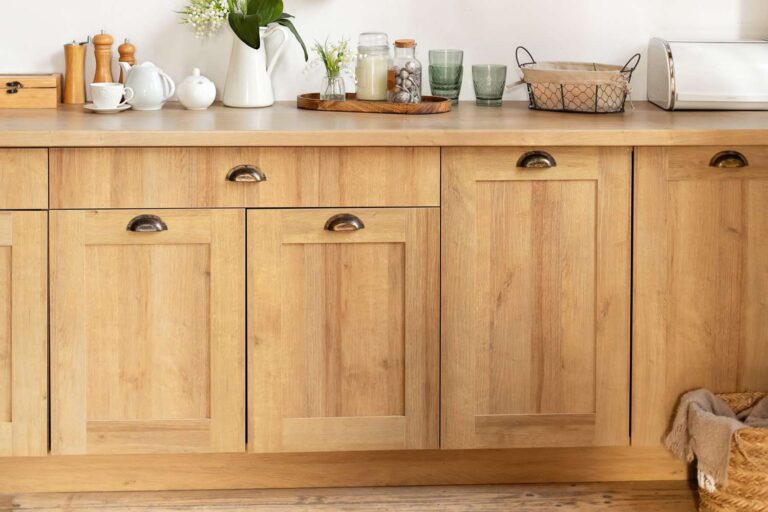Cabinets are the backdrop of your kitchen, so you want to keep them clean at all times. But everything from grease splattered on doors to crumbs strewn on shelves can cause dirt to build up in these nooks (and crannies). Every time you cook, these substances build up, so regular cleaning of your kitchen cabinets is a must. If your cabinets are made of wood or have a wood finish, you'll need to be extra careful with cleaning and drying to avoid damaging the material. Below, we spoke to experts about the best cleaning methods to keep your kitchen cabinets clean.
Materials needed
Make sure you have these tools on hand before tackling this chore.
- White vinegar
- Vacuum cleaner with crevice nozzle
- Spray bottle
- Liquid dishwashing detergent
- Microfiber Cloth
- Multi-purpose cleaner
How to Clean Wooden Kitchen Cabinets
Once you have gathered your cleaning supplies, you're ready to start cleaning your cabinets.
Before you begin
Before you begin, you should patch test the cleaning solution on your cabinets. “Wood is naturally porous and needs a protective finish to make it a hard, nonporous surface, so if the finish is in good condition, the cleaning agent can be used safely,” says Mary Gagliardi, in-house scientist and cleaning expert at Clorox. “If you're not sure if a finish is safe for your product, it's important to test it first in a hidden area before using it.” Once you know the product won't damage your cabinets, follow these steps to start cleaning:
Instructions
- Empty the inside of the cabinet.
- Use a crevice nozzle attachment to vacuum the inside of your cabinets.
- Mix equal parts white vinegar and warm water in a spray bottle and add a few drops of liquid dish soap to remove grease stains.
- Spray the outside of the door and allow the solution to sit for 1-2 minutes.
- Wipe clean with a microfiber cloth.
- Spray the inside of doors and shelves and let the solution sit for a minute or two.
- Wipe clean with a microfiber cloth.
- Dampen a clean cloth with water and wipe all surfaces that you cleaned with the vinegar solution.
- Use a clean microfiber cloth to thoroughly dry all surfaces.
How to Clean Stains from Wooden Cabinets
With heavy use of your kitchen, it's not uncommon to find stubborn stains remaining on your wooden cabinets even after thorough cleaning. Here's how to remove stains from your cabinets:
Materials needed
- Multi-purpose cleaner
- Nylon brush
- Microfiber Cloth
Instructions
- Spray the stain with an all-purpose cleaner and gently scrub with a nylon brush to remove the old stain.
- Rinse with cold water to remove any remaining product.
- Wipe dry with a microfiber cloth.
How to prevent age spots
The best way to remove stains is to prevent them from occurring, so Bella Peterson of Neighborly's Molly Maids says to create a protective barrier by applying a natural wood furniture wax to your kitchen cabinets every six months. “This will prevent oils, dirt, and other debris from sticking to the wood and discoloring it. For best results, spray the wax onto a cloth and rub it over the entire surface of your cabinets.”
How often should you clean your wooden cabinets?
Generally, a heavily used kitchen should have a thorough cleaning once a month and a touch-up once a week. However, how often you clean your wooden kitchen cabinets will depend on how often and what you cook. “When oils and fats heat up during cooking, some of the oil becomes airborne and spreads around the stove or oven, as well as throughout the room,” says Gagliardi. “Kitchen cabinets absorb oil and attract dust, which stains the cabinet surfaces and makes them harder to clean.”
Cabinet Drying
When cleaning wooden cabinets, it's essential to pay close attention to drying. “It's really important not to leave wood wet for too long as this can cause the wood to warp and swell,” says Melissa Poepping, founder of The Chemical Free Home. “Always dry the area thoroughly immediately after cleaning, taking care not to leave any water spots behind as this can cause stains.” If your microfiber cloth gets too damp when drying, immediately replace it with a dry cloth.


